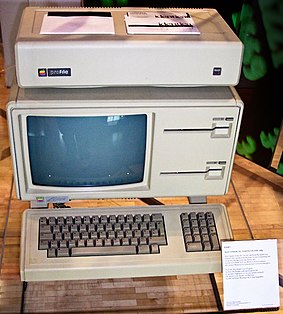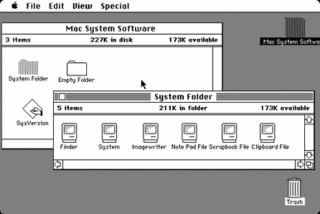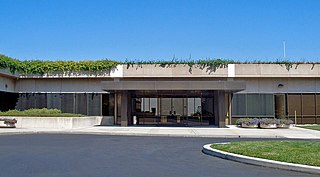
Lisa is a desktop computer developed by Apple, released on January 19, 1983. It is one of the first personal computers to offer a graphical user interface (GUI) in a machine aimed at individual business users. Development of the Lisa began in 1978, and it underwent many changes during the development period before shipping at US$9,995 with a 5 MB hard drive. The Lisa was challenged by a high price, insufficient performance, insufficient software library, crash-prone operating system, unreliable Apple FileWare ("Twiggy") floppy disks, and the immediate release of the cheaper and faster Macintosh — yielding lifelong sales of only 100,000 units in two years.

Jef Raskin was an American human–computer interface expert best known for conceiving and starting the Macintosh project at Apple in the late 1970s.

MacPaint is a raster graphics editor developed by Apple Computer and released with the original Macintosh personal computer on January 24, 1984. It was sold separately for US$195 with its word processor counterpart, MacWrite. MacPaint was notable because it could generate graphics that could be used by other applications. Using the mouse, and the clipboard and QuickDraw picture language, pictures could be cut from MacPaint and pasted into MacWrite documents.
Produced by Boston-based IDG World Expo, Macworld/iWorld is a trade show with conference tracks dedicated to the Apple Macintosh platform. It was held annually in the United States during January. Originally Macworld Expo and then Macworld Conference & Exposition, the gathering dates back to 1985.

System 6 is a graphical user interface-based operating system for Macintosh computers. It was released in 1988 by Apple Computer, Inc. and is part of the classic Mac OS series of operating systems. System 6 was included with all new Macintosh computers until it was succeeded by System 7 in 1991. The boxed version of System 6 cost $49 when introduced. System 6 is classed as a monolithic operating system. It features an improved MultiFinder, which allows for co-operative multitasking.

The Macintosh 128K, originally released as the Apple Macintosh, is the original Apple Macintosh personal computer. Its beige case consisted of a 9 in (23 cm) CRT monitor and came with a keyboard and mouse. A handle built into the top of the case made it easier for the computer to be lifted and carried. It had an initial selling price of $2,495. The Macintosh was introduced by the now-famous $370,000 television commercial by Ridley Scott, "1984", that aired on CBS during the third quarter of Super Bowl XVIII on January 22, 1984. Sales of the Macintosh were strong from its initial release on January 24, 1984, and reached 70,000 units on May 3, 1984. Upon the release of its successor, the Macintosh 512K, it was rebranded as the Macintosh 128K. This computer did not have a model number.
Burrell Carver Smith is an American engineer who, while working at Apple Computer, designed the motherboard for the original Macintosh. He was Apple employee #282, and was hired in February 1979, initially as an Apple II service technician. He also designed the motherboard for Apple's LaserWriter, and designed a low-cost version of the Apple II that eventually became the Apple IIe, using the same design techniques that he pioneered with the Mac.
The Command key (⌘), also historically known as the Apple key, clover key, open-Apple key, splat key, pretzel key, or propeller key, is a modifier key present on Apple keyboards. The Command key's purpose is to allow the user to enter keyboard commands in applications and in the system. An "extended" Macintosh keyboard—the most common type—has two command keys, one on each side of the space bar; some compact keyboards have one only on the left.
Guy L. "Bud" Tribble is Vice President of Software Technology at Apple Inc.

Chris Espinosa is a senior employee of Apple Inc., officially employee number 8. Having joined the company at the age of fourteen in 1976 when it was still housed in Steve Jobs' parents' garage, writing software manuals and coding after school, he is the company's current and all-time longest-serving employee.
Joanna Karine Hoffman is an American marketing executive. She was one of the original members of both the Apple Computer Macintosh team and the NeXT team.

The family of Macintosh operating systems developed by Apple Inc. includes the graphical user interface-based operating systems it has designed for use with its Macintosh series of personal computers since 1984, as well as the related system software it once created for compatible third-party systems.

Welcome to Macintosh is a 2008 documentary film focusing on computer company Apple Inc. and its Macintosh line of computers. The title comes from the original welcome message shown during the start-up of Macintosh computers.
Macintosh Basic, or MacBASIC, was both a comprehensive programming language and a fully interactive development environment designed by Apple Inc. for the original Macintosh computer. It was developed by original Macintosh team member Donn Denman, with help from fellow Apple programmers Marianne Hsiung, Larry Kenyon, and Bryan Stearns, as part of the original Macintosh development effort starting in late 1981.

Mike Boich was a major figure at Apple Computer who was in charge of demonstrating the first Macintosh to software developers and potential customers. He is notable as a technology evangelist who persuaded developers to write computer software. He was instrumental in hiring Apple entrepreneur Guy Kawasaki. His name is listed — as credited — inside the original Macintosh 128k.

Classic Mac OS is the series of operating systems developed for the Macintosh family of personal computers by Apple Inc. from 1984 to 2001, starting with System 1 and ending with Mac OS 9. The Macintosh operating system is credited with having popularized the graphical user interface concept. It was included with every Macintosh that was sold during the era in which it was developed, and many updates to the system software were done in conjunction with the introduction of new Macintosh systems.
Robert L. Belleville is an American computer engineer who was an early head of engineering at Apple from 1982 until 1985.

















